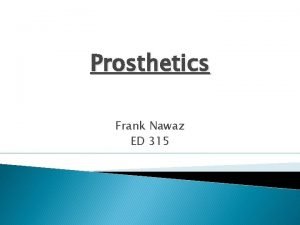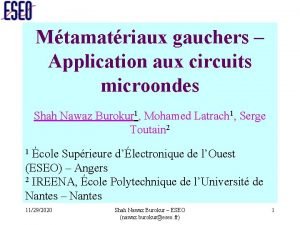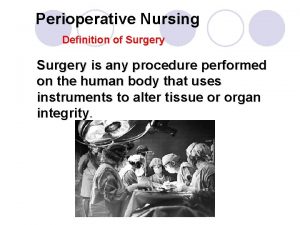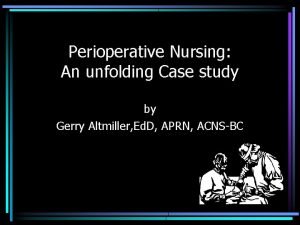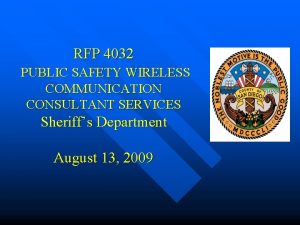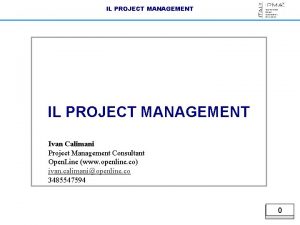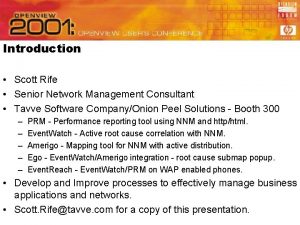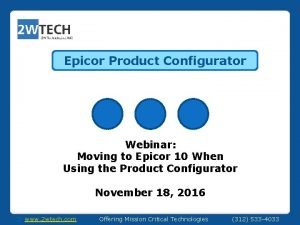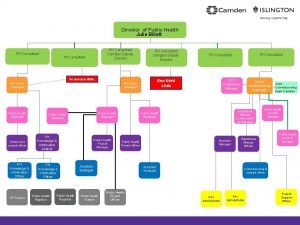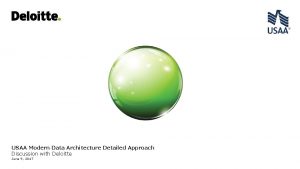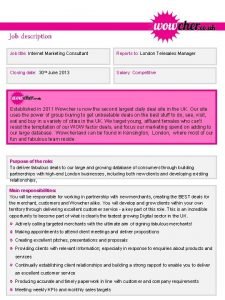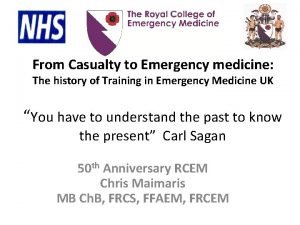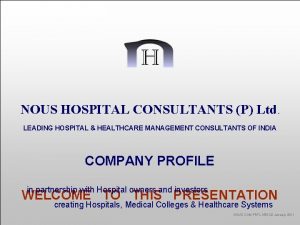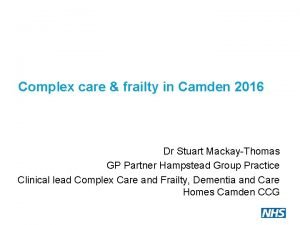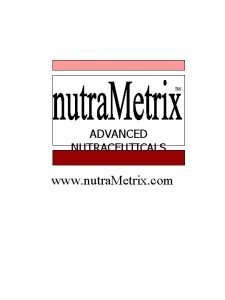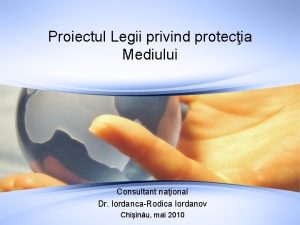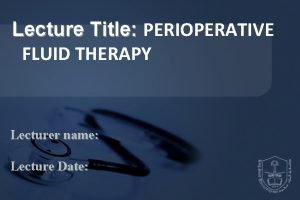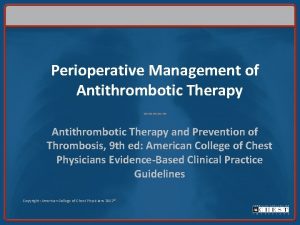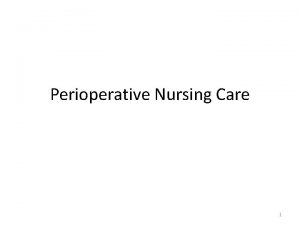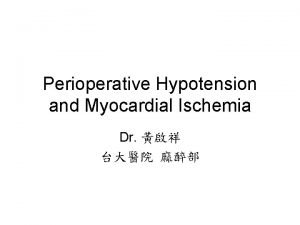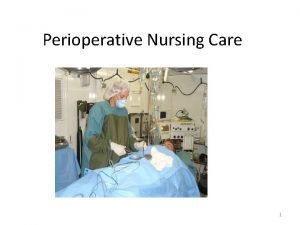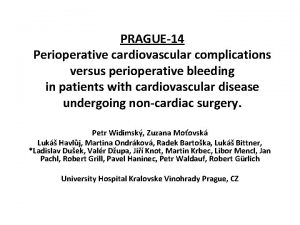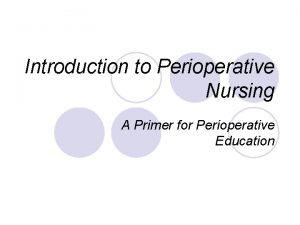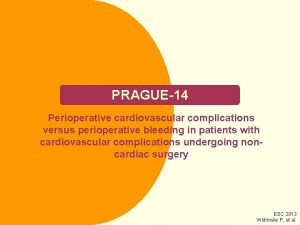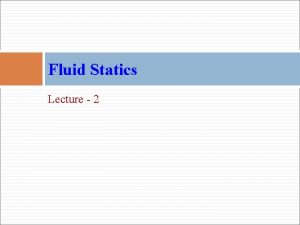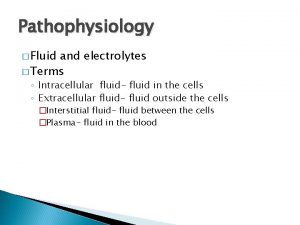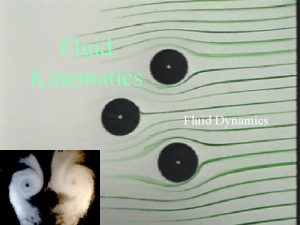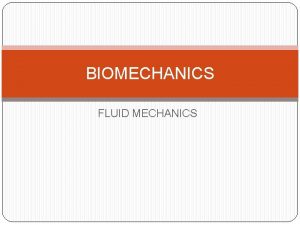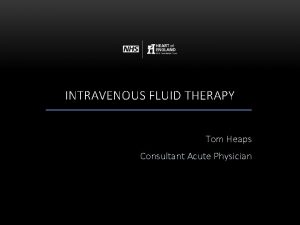PERIOPERATIVE FLUID THERAPY Sayeed Nawaz Consultant Anaesthesit Department


















































- Slides: 50

PERIOPERATIVE FLUID THERAPY Sayeed Nawaz Consultant Anaesthesit Department of Anesthesiology KKUH. King Saud University

Total Body Water (TBW) • • • Varies with age, gender 55% body weight in males 45% body weight in females 80% body weight in infants Less in obese: fat contains little water


Final Goals of Fluid resuscitation - Achievement of normovolemia& hemodynamic stability - Correction of major acid-base disturbances - Compensation of internal fluid fluxes - Improvement of microvascular blood flow - Prevention of cascade system activation - Normalization of O 2 delivery - Prevention of reperfusion cellular injury - Achievement of adequate urine output

Desirable outcome of fluid resuscitation - No peripheral edema - No ARDS

Fluid and Electrolyte Regulation • Volume Regulation - Antidiuretic Hormone Renin/angiotensin/aldosterone system Baroreceptors in carotid arteries and aorta Stretch receptors in atrium and juxtaglomerular aparatus Cortisol

Preoperative Evaluation of Fluid Status • Factors to Assess: - h/o intake and output blood pressure: supine and standing heart rate skin Urinary output mental status

Orthostatic Hypotension • • Systolic blood pressure decrease of greater than 20 mm. Hg from supine to standing Indicates significant fluid loss - Heart rate should increase as a compensatory measure - If no increase in heart rate, may indicate autonomic dysfunction or antihypertensive drug therapy

Perioperative Fluid Requirements The following factors must be taken into account: 1 - Maintenance fluid requirements 2 - NPO and other deficits: NG suction, bowel preparation 3 - Third space and invisible losses 4 - Replacement of blood loss 5 - Special additional losses: diarrhea

1 - Maintenance Fluid Requirements • Insensible losses such as evaporation of water from respiratory tract, sweat, feces, urinary excretion. Occurs continually. Adults: approximately 1. 5 ml/kg/hour • “ 4 -2 -1 Rule” applies to children • - 4 ml/kg/hr for the first 10 kg of body weight 2 ml/kg/hr for the second 10 kg body weight 1 ml/kg/hr subsequent kg body weight Extra fluid for fever, tracheotomy, open wounds

2 - NPO and other deficits • • • NPO deficit = number of hours NPO x maintenance fluid requirement. Bowel prep may result in up to 1 L fluid loss. Measurable fluid losses, e. g. NG suctioning, vomiting, ileostomy output, biliary fistula etc.

3 - Third Space & invisble Losses • • Isotonic transfer of ECF from functional body fluid compartments to non-functional compartments. Depends on location and duration of surgical procedure, amount of tissue trauma, ambient temperature, room ventilation.

Replacing invisible Losses • • Superficial surgical trauma: 1 -2 ml/kg/hr Minimal Surgical Trauma: 3 -4 ml/kg/hr - head and neck, hernia, knee surgery • Moderate Surgical Trauma: 5 -6 ml/kg/hr - hysterectomy, chest surgery • Severe surgical trauma: 8 -10 ml/kg/hr (or more) - AAA repair, nehprectomy

4 - Blood Loss • • Replace 3 cc of crystalloid solution per cc of blood loss (crystalloid solutions leave the intravascular space) When using blood products or colloids replace blood loss volume per volume

5 - Other additional losses • Ongoing fluid losses from other sites: - • gastric drainage ileostomy output diarrhea Replace volume per volume with crystalloid solutions

Example • • • 62, male, 80 kg, for hemicolectomy NPO after 10 PM, surgery at 8 AM, Received bowel preparation 3 hours long procedure with blood loss of 500 ml What is his estimated intraoperative fluid requirement?

Fluid requirement of this patient • • • Fluid deficit (NPO): 1. 5 ml/kg/hr x 10 hrs = 1200 ml + 1000 ml for bowel preparation = 2200 ml is total deficit: (Replace 1/2 first hour, 1/4 2 nd hour, 1/4 3 rd hour). Maintenance: 1. 5 ml/kg/hr x 3 hrs = 360 mls invisible Losses: 6 ml/kg/hour x 3 hours =1440 ml Blood Loss: 500 ml x 3 = 1500 ml Total = 2200+360+1440+1500=5500 mls

Intravenous Fluids: • • Conventional Crystalloids Colloids Hypertonic Solutions Blood/blood products and blood substitutes

Crystalloids • Combination of water and electrolytes - Balanced salt solution: electrolyte composition and osmolality similar to plasma; example: lactated Ringer - Hypotonic salt solution: electrolyte composition lower than that of plasma; example: D 5 W. - Hypertonic salt solution: 2. 7% Na. Cl.

Crystalloids in trauma Advantages: -Balanced electrolyte solution -Easy to administer -No risk of adverse reactions -No disturbance of hemostasis -Promote diuresis -Inexpensive

Crystalloids Disadvantages: -Poor plasma volume support -Large quantities needed -Reduced plasma oncotic pressure -Risk of edema Risk of hyprthermia

Hypertonic Solutions • Fluids containing sodium concentrations greater than normal saline. • Available in 1. 8%, 2. 7%, 3%, 5%, 7. 5%, 10% solutions. • Hyperosmolarity creates a gradient that draws water out of cells; therefore, cellular dehydration is a potential problem.

Hypertonic saline Advantages: -Small volume for resuscitation. -Osmotic effect -Inotropic effect (increase calcium influx in sarculima) -Direct vasodilator effect -Increase renal, mesenteric, splanchnic, coronary blood flow and arterial blood pressure

Hypertonic saline Disadvantages: • increase hemorrhage from open vessels. • Hypernatremia • Hyperchloremia. • Metabolic acidosis.

Crystalloids Lactated Ringer's Composition: Na 130, cl 109, K 4, ca 3, Lactate 28, Osmolarity 273 mosmol/l -Sydney Ringer 1880 -Hartmann added Lactate=LR -Minor advantage over Na. Cl Disadvantages: -Not to be used for dilution of blood (Ca citrate)

Crystalloids Dextrose 5% Composition: 50 gm /liter, provides 170 kcal /liter Disadvantages: -enhance CO 2 production -enhance lactate production

Composition

Colloids • • • Fluids containing molecules sufficiently large enough to prevent transfer across capillary membranes. Solutions stay in the space into which they are infused. Examples: hetastarch (Hespan), albumin, dextran.

Colloids Advantages: -Prolonged plasma volume support -Moderate volume needed -minimal risk of tissue edema -enhances microvascular flow

Colloids Disadvantages: Risk of volume overload Adverse effect on haemostasis Anaphylactic reaction Expensive

Crystalloids versus colloids Charactor In the vein Hemodynamics Infusion volume Plasma COP Tissue edema Anaphylaxis Cost Crystalloids Poor Transient Large Reduced Obvious Non-exist Inexpensive Colloids Good Prolong Moderate Maintain Insignificant low-mod Expensive

Clinical Evaluation of Fluid Replacement 1. Urine Output: at least 1. 0 ml/kg/hour 2. Vital Signs: Blood pressure and heart rate 3. Physical Assessment: texture of skin and mucous membranes; thirst in an awake patient 4. Invasive monitoring; CVP may be used as a guide 5. Laboratory tests: periodic monitoring of hemoglobin and hematocrit

Summary • Fluid therapy is critically important during the perioperative period. • The most important goal is to maintain hemodynamic stability and protect vital organs from hypoperfusion (brain, heart, kidneys, liver. ) • All sources of fluid losses must be accounted for. • Good fluid management goes a long way toward preventing problems.

Transfusion Therapy - 60% of transfusions occur perioperatively. - responsibility of transfusing perioperatively is with the anesthesiologist.

Blood Groups Blood Group Antigen on erythrocyte Plasma Antibodies A B AB O A B AB None Anti-B Anti-A None Anti-A Anti-B Rh Rh Incidence White African. Americans 40% 27% 11 20 4 4 45 49 42 17

Cross Match • Major: - Donor’s erythrocytes incubated with recipients plasma • Agglutination: - Is a sign of incompatibility - Type Specific: - Only ABO-Rh determined;

Type and Screen • Donated blood that has been tested for ABO/Rh antigens and screened for common antibodies (not mixed with recipient blood). - Used when usage of blood is unlikely, but needs to be available (hysterectomy). - Chance of hemolytic reaction: 1: 10, 000.

Blood Components è Prepared from Whole blood collection è Whole blood is separated by differential centrifugation X X X Red Blood Cells (RBC’s) Platelets Plasma Cryoprecipitate Others include Plasma proteins— Coagulation Factors, albumin, Growth Factors,

Transfusion Complications èAcute Transfusion Reactions èChronic Transfusion Reactions èTransfusion related infections

Acute Transfusion Reactions è Hemolytic Reactions (AHTR) è Febrile Reactions è Allergic Reactions è TRALI è Coagulopathy with Massive transfusions è Bacteremia

Complications of Blood Therapy • Hemolytic: - Wrong blood type administered (oops). Activation of complement system leads to intravascular heamolysis, spontaneous hemorrhage. Signs: hypotension, fever, chills dyspnea, skin flushing, substernal pain , Back/abdominal pain Oliguria Dark urine Pallor

Complications of Blood Therapy Signs are easily masked by general anesthesia. - Free Hemoglobin in plasma or urine - Acute renal failure - Disseminated Intravascular Coagulation (DIC)

Complications (cont. ) • Transmission of Viral Diseases: - Hepatitis C; 1: 30, 000 per unit Hepatitis B; 1: 200, 000 per unit HIV; 1: 450, 000 -1: 600, 000 per unit Parasitic and bacterial transmission very low

What to do? If an AHTR occurs è STOP TRANSFUSION è Maintain IV access and run IVF (NS or LR) è Monitor and maintain BP/pulse è Give diuretic, maintain urine output, fluid therapy è Obtain blood and urine for transfusion reaction workup è Send remaining blood back to Blood Bank

Monitoring in AHTR è Monitor patient clinical status and vital signs è Monitor renal status (BUN, creatinine) è Monitor coagulation status (DIC panel– PT/PTT, fibrinogen, D-dimer/FDP, Platelets, è Antithrombin-III) è Monitor for signs of hemolysis

Massive Blood Transfusion è Massive transfusion is generally defined as the need to transfuse one to two times the patient's blood volume. For most adult patients, that is the equivalent of 10– 20 units

Problems of massive transfusion è Dilutional thrombocytopenia and coagulopathy è Citrate toxicity è Hypothermia è Metobolic alkalosis è Hyperkalemia ( stored blood ) è DIC

How to avoid problems of massive transfusion è Use autologous blood transfusion è Cell saver technology è Substitute to blood artificial blood ( perflurocarbons )

Blood Substitutes • Potential Advantages: - No cross-match requirements Long-term shelf storage No blood-borne transmission Rapid restoration of oxygen delivery in traumatized patients Easy access to product (available on ambulances, field hospitals, hospital ships)

 Colloids fluids examples
Colloids fluids examples Usman nawaz missing
Usman nawaz missing Shah nawaz burokur
Shah nawaz burokur Nawaz sharif agriculture university multan
Nawaz sharif agriculture university multan Shifting dullness procedure
Shifting dullness procedure Fluid statics deals with fluid at rest
Fluid statics deals with fluid at rest Interstitial fluid vs extracellular fluid
Interstitial fluid vs extracellular fluid Fluid statics deals with fluid at rest
Fluid statics deals with fluid at rest Fluid kinematics definition
Fluid kinematics definition Intracellular fluid and extracellular fluid examples
Intracellular fluid and extracellular fluid examples Movement of body fluids
Movement of body fluids Synovial membrane
Synovial membrane Interstitial fluid vs extracellular fluid
Interstitial fluid vs extracellular fluid Psychoanalytic vs humanistic
Psychoanalytic vs humanistic What are the major humanistic therapies
What are the major humanistic therapies Bioness bits cost
Bioness bits cost Definition of perioperative
Definition of perioperative Perioperative nursing case study
Perioperative nursing case study Canadian perioperative guidelines
Canadian perioperative guidelines Phases of perioperative nursing
Phases of perioperative nursing Preoperative and postoperative care
Preoperative and postoperative care Wireless communication consultant
Wireless communication consultant Ivan calimani
Ivan calimani Philips talent acquisition
Philips talent acquisition Scott rife
Scott rife Judith james educational consultant
Judith james educational consultant Reza dorrani
Reza dorrani Ayurvedic lifestyle consultant
Ayurvedic lifestyle consultant Mcp mcts
Mcp mcts Epicor 10 product configurator
Epicor 10 product configurator Consultant knowledge management
Consultant knowledge management Consultant radiographer
Consultant radiographer Julie billett
Julie billett Modern data architecture consultants
Modern data architecture consultants A.s environs ltd is dealing in environment
A.s environs ltd is dealing in environment Consultant contract 2003
Consultant contract 2003 Partner technical consultant
Partner technical consultant Internet consultant job description
Internet consultant job description New consultant training
New consultant training Petrophysics
Petrophysics New consultant in casualty
New consultant in casualty Nous hospital consultant
Nous hospital consultant New consultant training
New consultant training Behavioral genetics consultant
Behavioral genetics consultant Engineers pi is 3
Engineers pi is 3 Stuart minty camden planning consultant
Stuart minty camden planning consultant Advanced nutraceutical sciences inc
Advanced nutraceutical sciences inc Verizon ip centrex
Verizon ip centrex Call script for recruiters
Call script for recruiters Sustainable tourism consultant jobs
Sustainable tourism consultant jobs Consultant mediu
Consultant mediu

